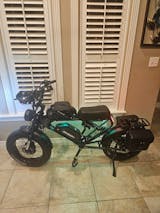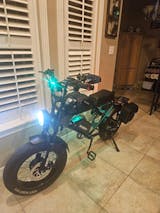Table of Contents
- Understanding Ebike Motor Wattage
- Performance Comparison: 250W, 500W and 750W
- 1. 250W Motor: Lightweight and Efficient
- 2. 500W Motor: Balanced Power & Versatility
- 3. 750W Motor: Maximum Torque and Speed
- 4. Key Takeaways :
- Factors to Consider When Selecting an Ebike Motor
- 1. Terrain and Riding Conditions
- 2. Legal Regulations
- 3. Battery Life and Energy Consumption
- 4. Cost and Maintenance
- What Ebike Motor Is Best?
- Conclusion
- FAQs
The electric bike has become as a popular green option for transportation across the globe. Choosing an appropriate electric motor wattage affects both the speed capabilities and torque output as well as battery drainage and terrain management capabilities therefore it requires precise motor selection based on your particular needs.
This article compares 250W, 500W and 750W ebike motors in terms of performance, efficiency and legal considerations. Exploring each motor type's advantages and limitations enables people from biking audiences of all kinds to make sound decisions about their bicycle motors.
The legal and efficient nature of 250W motors makes them ideal for urban cycling but riders who need additional power for hill climbing should choose a 500W system and off-road enthusiasts will benefit most from 750W motors. But which motor is best? Let's break down their key differences to help decide.
Understanding Ebike Motor Wattage
It is vital to have an in-depth knowledge of wattage when selecting an electric bike motor. Wattage refers to its power output and can impact speed capabilities, acceleration and hill climbing ability - however not all wattage ratings are created equal; two key terms to take note of are speed rating and acceleration capacity rating.
- Continuous power output refers to a motor's steady state power level without overheating.
- Peak power refers to its maximum short-burst wattage capacity - often when climbing hills or accelerating quickly.
Higher wattage motors supply greater torque which enables bicycles to elevate higher gradients as well as handle heavier freight effortlessly. The stronger electric motors decrease battery life while using up more power compared to lower-powered motors which results in decreased range.
Local laws regarding ebike motors differ across nations and states because some areas prohibit public road usage of bikes with over 250W motors. Every rider needs to verify current local biking laws before they choose their motorbike.
Wattage performance improvements come with increased battery performance coupled with laws that limit usage. The following text examines 250W, 500W and 750W motor options to determine their appropriate match for you.
Performance Comparison: 250W, 500W and 750W
Now that we understand motor wattage, let's compare 250W, 500W and 750W motors according to their performance, efficiency and suitability for different riding environments.
1. 250W Motor: Lightweight and Efficient
For flat terrains and urban commuting, the most popular among the mix is a 250W motor that is smooth and efficient and hence fitting for those who wants to ride comfort wise instead of power wise. Many regions impose legal limits at 250W which explains their wide availability. Here are its benefits.
-
Advantages of a 250W Motor
- Energy-Efficient - Utilizes less power, prolonging battery life and range.
- Legal in Most Locations - Commonly permitted for road use without special permits. Lower Maintenance Requirements - Reduces strain on motor components.
- Lightweight - Makes handling and maneuvering the bike simpler.
-
Disadvantages of 250W Motor
- Limited torque - Has difficulty with steep inclines and carrying heavy loads.
- Its Slower acceleration - Less power available to quickly reach high speeds.
- Unsuitable for off-road use: Due to lacking the required torque and power for rough terrain terrain.
Best for: Riders on flat roads, those commuting short distances and those wanting extended battery life. However, a 250W motor may feel inadequate on routes with steep hills or heavy loads.
2. 500W Motor: Balanced Power & Versatility
The 500W motor strikes the perfect balance between power and manoeuvrability and is recommended for looking for faster acceleration without excessive battery consumption. Furthermore, its excellent performance on moderate inclines while still maintaining an acceptable range make this motor an attractive option.
-
Advantages of the 500W Motor
- Stronger torque - Provides more control for hilly terrains compared to 250W motors.
- Balanced speed capabilities - Faster but not overly aggressive speeds than 250W models, yet suitable for city riding as well as light off-road use.
- Multipurpose use - Suited both city use as well as light off-road.
-
Disadvantages of 500W Motor
- Moderate battery drain - Consumes more power than 250W motors.
- May not be street legal in certain locations - Certain areas restrict motor wattages above 250W and prohibit their use on public roadways.
- Heavier than a 250W motor - Adds weight to the bike.
Best For: Riders who commute in areas with moderate hills, are looking for greater acceleration, and need an efficient option between power and efficiency. Ideal all-rounder but may not provide enough power for steep hills or rough trails.
3. 750W Motor: Maximum Torque and Speed
If you need a motor that will provide maximum torque as well as speed capabilities, a 750W motor may be what you need. This powerful motor boasts strong acceleration capacities, and making an excellent choice for off road adventures by steep hills or carry heavy loads.
-
Benefits of a 750W Motor
- Superior torque allows the bike to easily climb steep inclines and transport heavy riders.
- Its fast acceleration quickly reaches top speed with minimal effort required to achieve top speed.
- Ideal for off-road riding with its rugged terrain capabilities and challenging landscapes.
-
Disadvantages of a 750W Motor
-
Higher battery consumption - This motors will quickly drain your power, draining it faster than its 250W or 500W counterpart.
- Might be illegal for street use – Some regions restrict motors over 500W.
- Heavy and bulkier - They add weight to your ebike and require larger batteries.
-
Higher battery consumption - This motors will quickly drain your power, draining it faster than its 250W or 500W counterpart.
Best For: Riders who need extra power, frequently ride steep hills, or plan to use their ebike for off-road trails. However, the increased battery drain and legal restrictions should be considered.
4. Key Takeaways :
- 250W motors work great in flat terrain environments as they allow longer battery life.
- 500W motors provide an optimal balance of power and efficiency, making them perfect for moderate hills.
- 750W motors deliver maximum torque and acceleration, making them great choices for off-road riding on steep inclines or off-road trails.
Factors to Consider When Selecting an Ebike Motor
After our analysis of 250W 500W and 750W motor types has prepared us to select an ebike motor wattage that suits terrain type, legal needs and battery efficiency and budget constraints.
1. Terrain and Riding Conditions
Your terrain plays an integral part in choosing an optimal motor wattage:
- Flat city roads? A 250W motor is sufficient, offering better battery life and legal compliance.
- Moderate hills and mixed terrain? A 500W motor provides a balance of power and efficiency.
- Steep hills or off-road trails? A 750W motor delivers the necessary torque and acceleration.
For daily commuters who frequently encounter hilly terrain, however, a 250W or 500W motor would save battery power, but for hillier terrain where frequent hill climbing occurs a 750W motor might provide easier riding but decrease battery life faster.
2. Legal Regulations
Ebike motor legalities vary by country and region.
- In Europe and Australia, most public road ebikes are capped at 250W.
- In the United States, federal law allows ebikes up to 750W, but state laws may differ.
- Some regions require licensing or registration for ebikes with motors above 500W.
Before purchasing a 500W or 750W motor, check your local laws as some places consider high-wattage ebikes as motorcycles requiring license and insurance.
3. Battery Life and Energy Consumption
In terms of battery life and energy consumption, larger motor wattages tend to drain batteries more quickly;
- A 250W motors offer longer range per charge.
- A 500W motor uses slightly more energy but still delivers acceptable efficiency.
- A 750W motors require significantly larger batteries to function optimally.
If battery range is a priority, 250W or 500W motors would likely be superior; otherwise they might provide extra torque for hills or off-road riding.
4. Cost and Maintenance
Higher wattages generally mean higher costs:
- 250W motors tend to be more affordable and require less maintenance.
- 500W motors tend to be moderately priced but may require stronger components.
- 750W motors cost more and require better batteries and motor controllers.
For budget-conscious riders, a 250W motor provides long-term savings. however, off-road riders may find the higher maintenance costs worth their while.
What Ebike Motor Is Best?
Selecting an ebike motor wattage that best meets your riding needs depends on its intended usage and intended location. Each size offers distinct benefits and drawbacks:
- Best for City Commuting: 250W motors offer energy efficiency, legality and provide longer battery life than their counterparts.
- Best for Mixed Terrain: A 500W motor provides the ideal balance of speed capabilities, efficiency and moderate hill climbing ability.
- Best for Hills & Off-Road Adventures: A 750W motors deliver maximum torque and acceleration that's ideal for steep inclines or rough terrains.
Considering battery life and legal compliance as top priorities, opt for a 250W motor. However, for more power you might require 500W or 750W.
Conclusion
Knowing what difference between a 250W , 500W and a 750W ebike motor does makes it easy for a rider to pick out the motor that best suits his or her needs. 250W motors are good for commuters and the 500W offer versatility in solving varied but varying terrain. In the end, powerful 750W motors come with an acceleration and torque that’s very strong, but this comes with extra battery power being needed, and possibly even with legal restrictions that should be considered first before the motors can be used.
So before you buy, make sure to determines your terrain, the local laws, and battery capacity you’re looking for in an electric bike motor. An efficient motor is paramount when riding an ebike as it helps you to get the most experience out of your ebike, while staying within safety standards and following specified regulations.
FAQs
1. How Does Motor Wattage Affect an E-Bike's Performance?
The higher the wattage, the faster your acceleration, hill climbing abilities, 500w motors typically offer more power than a 250w motors, good for riders that are pushing up hill or carrying heavy loads.
2. Are Higher Wattage E-Bikes Faster?
Ebikes with higher wattage can reach higher speeds yes. A 500W motor will usually attain greater speeds than the 250W motor.
3. Does a higher wattage motor consume more battery power?
Higher wattage motors on e-bikes primarily use up and drain more of your battery power and thus decrease your range. And it’s important that your power requirements and desired range remain equal.




















